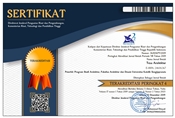THE EFFECTS OF POPULATION GROWTH ON MORPHOLOGICAL DEVELOPMENT OF BALINESE TRADITIONAL VILLAGE : Bayung Gede Village, Kintamani District, Bangli City, Bali Province
Abstract
Keywords
Full Text:
download PDFReferences
Alit, I. K. (2004). Morfologi Pola Mukiman Adati Bali. Jurnal Permukiman Natah, 2(2), 56–107.
Arnawa, I. K., Runa, I. W., Astuti, P. S., Palgunadi, P., Raka, I. D. N., & Martini, L. K. B. (2015). Pengembangan Desa Wisata Bayung Gede Kecamatan Kintamani Kabupaten Bangli, Bali. Statewide Agricultural Land Use Baseline 2015, 1, 76–83. 890
Budihardjo, E. (1986). Architectural Conservation in Bali. Yogyakarta: Gajah Mada University Press.
Covarrubias, M. (2013). Pulau Bali Temuan Yang Menakjubkan. Denpasar: Udayana University Press.
Dewi, N. W. L. O. (2015). Perubahan Unsur Ritus Keagamaan Masyarakat Bali Aga Di Desa Bayung Gede, Kecamatan Kintamani, Bangli, Bali. Humanis, 12, No.3, 1–8.
Dwijendra, N. K. A. (2003). Perumahan dan Permukiman Tradisional Bali. Jurnal Permukiman “Natah,”1(1), 8–24.
Kumurur, V. A., & Damayanti, S. (2009). Pola perumahan dan pemukiman desa tenganan bali. Jurnal Sabua, 1(1), 1–7.
Mucuk, J. K. (2016, April 18). Morfologi Desa Bayung Gede, Company Visit 2016, Master of Architecture, Atmajaya University Yogyakarta. (F. Pangasih,
Interviewer)
Prayogi, P. A. (2011). Dampak Perkembangan Pariwisata Di Objek Wisata Penglipuran. Jurnal Perhotelan Dan Pariwisata, 1(1), 64–79.
Prayogi, P. A., & Sonder, I. W. (2014). Pengembangan Rumah Tradisional Sebagai Sarana Akomodasi Di Desa Bayung Gede, Kabupaten Bangli. Jurnal Perhotelan Dan Pariwisata, 4(2), 235–247.
Putri, D. A. E. (2015). Kearifan Ekologi Masyarakat Bayung Gede Dalam Pelestarian Hutan “Setra Ari-Ari” Di Desa Bayung Gede, Kecamatan Kintamani, Kabupaten Bangli. Skripsi Program Studi Antropologi Fakultas Ilmu Budaya Universitas Udayana Denpasar 2015.Denpasar: Udayana University Press.
Reuter, T. A. (2005). Custodians Of The Mountains: Culture and Society in the Highlands of Bali. Jakarta: Yayasan Obor Indonesia.
Zahnd, M. (1999). Perancangan Kota secaraTerpadu-Teori Perancangan Kota dan Penerapannya. Yogyakarta: Kanisius.
Website
Google, Google Earth Pro, https://www.google.com/enterprise/mapsearth/products/earthpro.html.Retrieved on 9 May 2016, at 16:24 WIB.
DOI: https://doi.org/10.24167/tesa.v15i1.690
ISSN 1410-6094 (Print) | ISSN 2460-6367 (Media Online) | View My Stats

This work is licensed under a Creative Commons Attribution 4.0 International License.








